If you are reading these rules for the first time, ignore the text along the right hand side. These rules serve as a summary to help you quickly familiarize yourself with the game.
The goal of the game is to build your plantations on the board in a way that earns you the most income in the form of points.
You earn points for each plantation built as well as for landscape tiles collected. Additional points are awarded to the players
with the largest plantation regions adjacent to a Finca when it is scored. In order to build plantations, you must have enough
money. Therefore, it is essential to harvest some of your plantations from time to time in order to collect the needed income.
Playing the Game:
The player on turn performs either the action Build or the action Harvest.
In addition, they may perform one or more special actions using their landscape tiles at any time during their turn.
Beginning with the starting player, the game proceeds in a clockwise direction.
When it is your turn, you have the choice between two actions:
-
Build: buy plantations from the market and build immediately on the game board.
-
Harvest: score at least one plantation region and collect income.
A player must perform one of these actions.
Passing a turn is not allowed.
In addition, you may perform one or more special actions
using your landscape tiles at any time and in any order during your turn.
Action: Build
Buy all the plantations in a row.
1 Coin per plantation.
The acquired
plantations must be built immediately.
Only buy when you can build.
Start new plantations next to a Finca.
Workers mark your own regions.
Harvested regions are neutral.
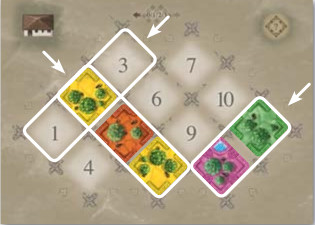
Select a row from the market (marked with arrows) and buy
all the plantations from that row. Then pay 1 coin for each
plantation by moving your money marker back that many coins
on your player mat’s money track.
Example: The player may buy plantations from any row as long
as they have enough money. Three possibilities are marked in the
image.
You must always buy all the plantations in a row. The acquired
plantations must then be built immediately on the game board. It
is not allowed to store plantations for later. Buying and building
is regarded as a single action. (If there are 3 or less plantations
left on the market after buying, a new Finca is built and the
market will be refilled.)
If you cannot pay for all the plantations in a row, or you cannot build them all, you may not buy that
row.
If, however, you mistakenly take a row of plantations from the market and then realize that you cannot pay for or
build all of them, you must place the tiles you cannot build back in the market in the order of the numbers on the market
spaces. You receive a penalty of minus 3 points for each tile you must return to the market (move your worker on the
scoring track accordingly).
You can build new plantations on the game
board in two ways:
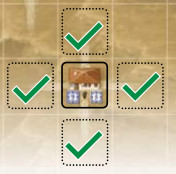
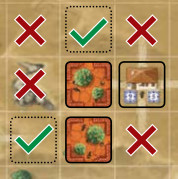
-
By placing adjacent a matching plantation that is
part of your own region (marked with one of your
workers).
-
By starting a new region of plantations adjacent to
the road leading from a Finca. (On every Finca there
are 4 roads where new regions may be started.)
When you begin a new plantation region, take the right-most worker from your player mat and place it onto the newly
placed plantation. If you are expanding one of your regions, no further workers are necessary.
When a plantation region is harvested, the worker from that region is removed. Plantation regions without workers are
neutral and do not belong to anyone.
Building Rules:
Rocks and construction sites are off limits.
On every road leading from a Finca, a different color
(exception: Family game variant).
Cannot be adjacent to a plantation region owned by a different player.
Merging with your own regions or neutral ones (if at most same size) possible.
When building plantations, you must observe the following rules:
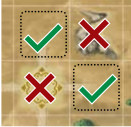
-
You may only build plantations on open spaces or spaces where landscape tiles are placed.
You may not build plantations on spaces with rocks or building sites for Fincas.
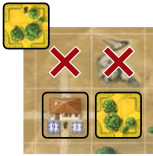
-
Each road leading from a Finca (as well as from a building site) must have a different
colored plantation. (See image: Since there is already a lemon plantation next to the road
on the right, an additional lemon plantation may not be built next to the upper road).
NOTE: For the family variant, this rule does not apply.
-
Plantation regions of the same color owned by different players
cannot be adjacent to each other.
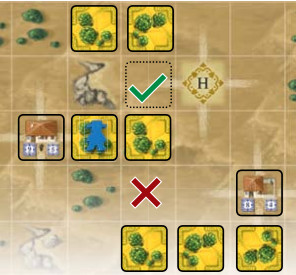
Merging: You may, however, merge plantation regions of the same
color under the following circumstances:
-
You may build a plantation that joins two of your own plantation
regions of the same color. Return one of the workers immediately
to your player mat (the left-most free space on your player mat).
-
You may build a plantation that connects one or more of your regions to
one or more neutral regions of the same color, provided that the total size
of your regions is at least as large (number of tiles) as the total size of
the neutral regions before the merger. If the total size of the neutral regions
is larger merging is off-limits.
Usually you will merge one of your regions with one neutral region.
Events after Building:
If you build on a space with a landscape tile, you take the landscape tile.
Landscape tiles award points or allow special actions.
Taking landscape tiles:
The specific actions of individual tiles are explained at the end of the game rules.
Scoring at the end of the turn when a Finca is circled.
Determine total of plantations in regions adjacent to the Finca for each player.
Points for the most and second-most (if first place is a draw, no points for second place are awarded).
Scoring a Finca:
If, at the end of a turn, all 8 spaces around a Finca (including diagonally adjacent) are occupied (by plantations, landscape
tiles or rocks), that Finca is scored.
Now determine who has the largest total of plantations in regions adjacent (also diagonally) to that Finca. The size of
each region is the number of plantation tiles in that region. If a player has several plantation regions adjacent to the
Finca, the plantations of each of those regions are added together.
The player with the most plantations is awarded the higher value of points given on the Finca tile. He moves his worker
on the scoring track that number of spaces forward. The player with the second most number of plantations receives the
lower value of points. All other players receive nothing.
If several players are tied for the most
plantations, all of these players receive the
full number of points for 1st place and no
players receive points for 2nd place. If there
are several players who have the second-most
number of plantations, each of them receive
the full number of points for 2nd place.
If there is only one player left with regions
adjacent to a Finca when it is scored, he only
receives the points for 1st place.
Then flip the Finca tile face-down to indicate that
it has been scored.
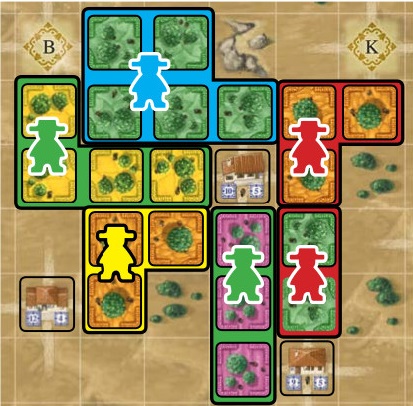
Example: Klemens (blue) has a region of 5 lime
plantations, Stefan (red) has 2 lime and 3 orange,
Anja (yellow) has 3 orange, Andrea (green) has 4 lemon and
3 grapefruit. Andrea (7 in total plantation tiles)
scores 10 points, Klemens and Stefan (both 5)
receive 5 points each.
Place new finca and refill the market if 3 plantation tiles or fewer are available in the market.
First the Finca, then build plantations, then refill the market.
New Finca and refill the market:
If, after you take plantations from the market, there are 3 or fewer plantations remaining there, and the market was refilled
completely the last time this happened, you must immediately
build a new Finca.
Draw the top finca tile from the stack, choose one of the 3 building site tiles on the game board, and
replace the tile with the new Finca. Remove the building site tile from the game and draw a new one from the stack,
adding it to its matching space on the game board (same character).
-
After placing the Finca, build your newly purchased plantations on the game board, following the building rules.
You may now, however, begin new regions adjacent to the roads of the new Finca.
-
Then refill the plantation market by drawing tiles from the cloth bag and placing them on the free spaces in the market
in the order of the numbers on those spaces until all 12 spots are filled.
-
If there are not enough tiles left in the bag, the market is not completely filled.
Additional fincas can now only come into play by using the Landscape tile "Milestone".
Action: Harvest
Harvest one of your plantation regions, score 1 point per tile and 1 point per well on a tile.
Return worker to your player mat.
At the end of the harvest action, gain income based on the number of workers on your player mat.
Instead of building, you may harvest one or more of your plantation regions, as long as you possess at least one on the
board. Harvesting plantations awards you with points and income.
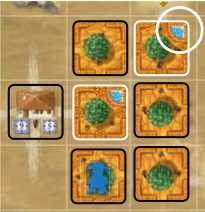
-
For each plantation tile harvested, you receive 1 point. For each plantation
tile with a well, you receive 2 points.
-
After scoring a region of plantations, you take the worker from that region
and place it back in the left-most free space on your player mat.
Harvested plantations remain on the board. They belong to no one
and are considered neutral. No player may add plantations to a
neutral region.
(exception: merging with own region, see action Build).
Example: Klemens harvests his region of 6 orange plantations, 2 of which
have a well. He earns 8 points and his worker comes back to his player mat.
-
The points are recorded using the worker on the scoring track.
-
If you don't want to harvest another region, you receive your income. The income depends on the number of
workers on your player mat. If 1 worker is there after harvesting, you receive 2 coins, if there are two workers, you
get 4 coins, with 3 workers you receive 6 coins, for 4 workers 7 coins, and with 5 workers 8 coins.
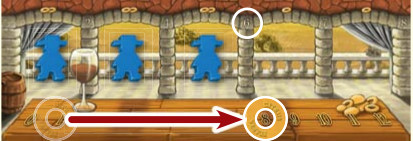
Example: After harvesting, Klemens has
3 workers on his player mat. He receives
6 coins income.
-
Move your marker on the money track forward
the appropriate number of spaces to record
your income. The maximum amount of money
you can have is 12 coins. If you receive income
that would exceed this limit, keep the marker
on “12” and the rest of the income is forfeited.
End of the game:
The game ends when all the plantation tiles have been built.
Points for the majority of tiles next to fincas (use smaller point value, no points for other players).
All plantations are harvested and scored.
Points for Landscape tiles, 1 per unused action tile, Wild horses 1 point per horse.
The game ends when all the plantation tiles have been built.
All Fincas which have not been encircled are now scored. This time, however, only the player with the most plantations in regions
adjacent (also diagonally) to the Finca receives points, and he receives the smaller number (what the 2nd place player would receive
during the game). No points are awarded for the second-most plantations and for all other players. If there is a tie for the most, then all
of those players receive the full number of these points.
-
Afterwards, all plantations that still have workers are harvested for points.
-
Finally, each player adds points to his score from his landscape tiles. Wild Horses are worth 1 point per horse, and each action tile
that was not used is worth 1 point.
-
All points are marked on the scoring track.
The player whose worker is farthest on the track wins. In case of a tie multiple players may win.
The online game scores the points for Wild Horses immediately when gaining the tile!
Variants:
1. Shorter game
-
Only recommended for 2-3 players!
-
Use the side of the board with fewer spaces.
-
For the short version of the game, fewer plantation tiles are needed. From each color remove a total of 5 tiles (3 without
wells and 2 with wells).
-
Use 3 Fincas at the beginning (instead of 4) on building sites A, B and C.
-
Remove the building site tiles A, B and C, as well as L, M, N and O from the game.
-
In the short version of the game, some Fincas are built on the edge of the board. These Fincas are scored when the
surrounding 5 spaces on the board are occupied.
Adaptation for the online game:
-
From each color a total of 6 tiles (4 without wells, 2 with wells) are removed.
-
The 4 landscape tiles bridge are always in play.
-
When playing with the new landscape tiles, the 3 landscape tiles plow are always in play.
These adjustments should make it less likely that there are plantations in the market that
none of the player can build.
2. Family game
For the family version of the game, the 2nd building rule is omitted, that is, each road from a Finca does not need to have a
plantation of a different color. This simplifies building and the game will be easier for younger players to grasp.
3. Random starting building sites
-
Instead of the starting Fincas on building sites A-D, random starting positions can be selected. For this purpose, all
15 building site tiles are shuffled face down. The top four are drawn and the starting Fincas are placed on the corresponding
building sites.
-
(Another option is to build only 3 starting Fincas instead of 4, thereby limiting the building possibilities even further.)
Note: Theoretically, it is conceivable that a player is unable to perform any action, when all his plantations are harvested and there are no plantations
available for him to build. This case has not occurred in numerous playtests, but should it happen, the player simply passes. If the game is blocked and
no other player can take a turn, a new Finca is added to the game board according to the rules (see “New Finca and refill the market”).
If still no player can perform a turn, the game will end immediately.